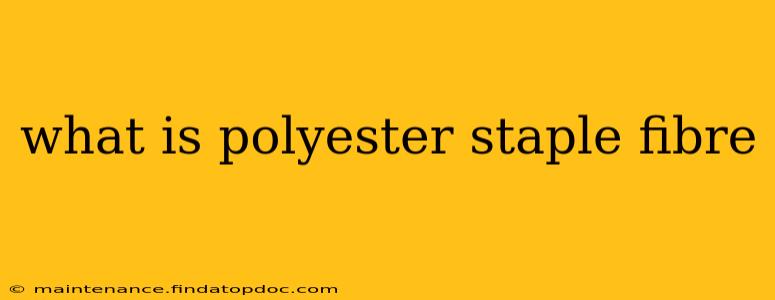Polyester staple fiber is a synthetic fiber, a fundamental building block in countless textiles we use daily. Understanding its properties and applications is key to appreciating its widespread use in clothing, home furnishings, and industrial materials. This comprehensive guide will explore everything you need to know about polyester staple fiber, answering common questions and delving into its unique characteristics.
What are the properties of polyester staple fiber?
Polyester staple fiber boasts several advantageous properties that contribute to its popularity. These include:
- High Strength: Polyester fibers are exceptionally strong, meaning fabrics made from them are durable and resistant to tearing.
- Excellent Elasticity and Resilience: They retain their shape well, resisting wrinkles and stretching, making them ideal for garments requiring consistent form.
- Moisture-Wicking: While not as effective as some other fibers, modern polyester blends often include moisture-wicking treatments to improve comfort.
- Resistance to Shrinking and Stretching: Polyester is relatively dimensionally stable, meaning garments made from it are less prone to shrinkage or stretching over time.
- Easy Care: Polyester is resistant to wrinkles and generally requires minimal ironing, making it a low-maintenance option.
- Affordable: Polyester is a relatively inexpensive fiber to produce, contributing to its widespread use in various applications.
- Resistance to Chemical and Biological Degradation: This makes it durable and suitable for various harsh environments.
- Versatile: It can be blended with other fibers to create fabrics with diverse textures and properties.
How is polyester staple fiber made?
Polyester staple fiber is produced through a complex process involving several steps:
- Polymerization: The process begins with the polymerization of ethylene glycol and terephthalic acid to form polyethylene terephthalate (PET), the base material for polyester.
- Melt Spinning: The PET is melted and then extruded through tiny spinnerets, forming continuous filaments.
- Cutting: These filaments are then cut into short lengths, creating staple fibers. The length of these fibers influences the final fabric's texture and properties.
- Texturizing (Optional): Many polyester staple fibers undergo texturizing processes to improve their softness, bulk, and drape. This process can involve techniques like crimping, twisting, or air jet texturing.
- Finishing: The fibers may undergo further finishing processes to add properties like stain resistance, water repellency, or wrinkle resistance.
What are the different types of polyester staple fiber?
Polyester staple fibers are available in a wide variety of types, differing in fineness, length, and properties:
- Different Deniers: Denier refers to the fineness of the fiber. Higher denier fibers are thicker and coarser, while lower denier fibers are finer and more delicate.
- Lengths: Fiber length influences the final fabric's texture and properties. Longer fibers generally produce stronger and smoother fabrics.
- Modifications: Polyester fibers can be modified to enhance specific properties, such as adding anti-static agents, flame retardants, or antimicrobial finishes.
What are the advantages of using polyester staple fiber?
The advantages of using polyester staple fiber are numerous, including its strength, durability, ease of care, and affordability. These qualities make it a versatile choice for various applications.
What are the disadvantages of polyester staple fiber?
While polyester staple fiber offers many benefits, some disadvantages exist:
- Hydrophobic Nature: Polyester doesn't breathe as well as natural fibers like cotton, leading to potential discomfort in hot and humid conditions.
- Environmental Concerns: The production of polyester involves petroleum-based resources and can contribute to environmental pollution if not managed responsibly.
- Pilling: Polyester fabrics can be prone to pilling, where small balls of fiber form on the surface of the fabric.
What products use polyester staple fiber?
Polyester staple fiber finds its way into a vast array of products, including:
- Clothing: A major application of polyester staple fiber is in apparel, often blended with other fibers to enhance durability and performance.
- Home Furnishings: Polyester is used in carpets, upholstery, curtains, and other home textiles.
- Industrial Fabrics: It's employed in applications requiring high strength and durability, such as filter cloths, conveyor belts, and geotextiles.
- Nonwovens: Polyester staple fibers are used extensively in nonwoven fabrics for various applications, such as wipes, disposable garments, and medical supplies.
Is polyester staple fiber environmentally friendly?
The environmental impact of polyester staple fiber is a complex issue. While the production process can be energy-intensive and generate waste, advancements are being made towards more sustainable production methods, including the use of recycled materials and reduced emissions. The overall environmental impact depends heavily on the manufacturing practices and end-of-life management of the fiber.
This comprehensive overview provides a detailed look at polyester staple fiber, its properties, production, applications, and environmental implications. By understanding these aspects, you can appreciate its significant role in the textile industry and its continued importance in various applications.
